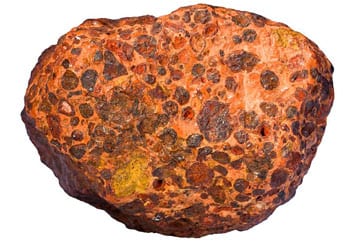Tīpakohia Reo:
Konumohe Ko te huānga whakarewa tino noa kitea i runga i te whenua, totaling about 8% o kirinuku o te whenua. Heoi, aluminum as an element is reactive and therefore does not occur naturally – it needs to be refined to produce aluminum metal. Ko te rauemi tīmatanga tuatahi mō te konumohe tahu para bauxite, puna arumoni matua o te ao o te konumohe. Bauxite is a sedimentary rock, and consists mostly of the aluminium minerals gibbsite (al(OH)3), boehmite (c-Ålö(OH)) me diaspore (he-Ålö(OH)), and is usually mixed with the two iron oxides goethite and hematite, the aluminium clay mineral kaolinite and small amounts of anatase (TiO2) and/or ilmenite (FeTiO3).

putunga bauxite he horapa te ao, te nuinga tupu i roto i te rohe pārūrū pārū ranei. Although proven reserves of bauxite are expected to last for many years, Kei te heke te kounga o te rahui e taea te ōhanga uru. hoki kaimahi koura, who are in the business of bauxite processing to make alumina, me whakarewa iku konumohe, Ko te wero ki e rua pānga pūtea, me te taiao tenei.
The process to refine metallurgical bauxite into alumina involves the following inputs:
The following outputs are generated:

The most widely used chemical process of refining bauxite into alumina, the Bayer process, involves dissolving the Al2O3 out of the bauxite rock with caustic soda (NaOH) at elevated temperature and pressure. The Al2O3 fraction of the bauxite is dissolved into solution, to later be precipitated out as alumina. Heoi, a high-grade bauxite contains up to 60% Al2O3, and many operating bauxite deposits are well below this, wā rite iti rite 30-40% Al2O3. Because the desired product is a high purity Al2O3, te toe waikura i roto i te bauxite (Fe2O3, SiO2, TiO2, Organic material) are separated from the Al2O3 and rejected as alumina refinery resides (faanahohia) or red mud. I roto i te whānui, te kounga o raro te bauxite (ie lower Al2O3 content) the more red mud is generated per ton of alumina product. I tua atu, even some Al2O3 bearing minerals, pērā kaolinite, produce un-desirable side reactions during the refining process and lead to an increase in red mud generation, me te te mate o te utu matū konutai waihā, he utu tāupe nui i roto i te tukanga para bauxite.
paru Whero fokotu'utu'u ranei tohu te nui, me te i runga i-haere wero mo te ahumahi konumohe. Kei paru Whero waihā wäriu toenga matū nui i te tukanga para, a ko tino kawakore, maha ki te pH o 10 - 13. It is generated in large volumes worldwide – according to the USGS, tata production alumina ao ko 121 miriona toni i roto i 2016. This likely resulted in more than 150 miriona toni o paru whero hangaia i roto i te wā kotahi. Ahakoa rangahau haere tonu, paru whero tēnei wā he torutoru ara arumoni taea ki painga re-whakamahi. Kei te tata te reira e iti rawa o te paru whero ko nga painga o re-whakamahia te ao. Instead the red mud is pumped from the alumina refinery into storage impoundments or landfills, te wahi e rongoa ai, ka aroturuki i te utu nui.
Ko te mate o te konutai waihā utu (NaOH) and the generation of red mud are both related to the quality of the bauxite used in the refining process. I roto i te whānui, the lower the Al2O3 content of the bauxite, te nui te rōrahi o te paru whero kia e ka hanga, as the non-Al2O3 phases are rejected as red mud. I tua atu, the higher the kaolinite or reactive silica content of the bauxite, ka te paru atu whero kia hanga. The reactive silica content not only increases the volume of red mud, but also consumes caustic soda reagent and reduces the yield of Al2O3 recovered from the bauxite. Na reira, there is both an economic and environmental argument to be made for improving the quality of bauxite prior to refining.
Ko te tukanga STET maroke wehenga e horo'a bauxite kaihanga ranei kaimahi koura bauxite ha faingamālie ki te mahi i mua-Bayer-tukanga whakahoutanga o te ore bauxite ki te whakapai ake i te kounga. He maha ngā painga tenei huarahi:
I roto i te whakarāpopototanga, tukatuka maroke nga whai wāhitanga STET whakawehe horo'a ki ki te whakaputa uara mō ngä bauxite me kaimahi koura. Ko te mua-tukatuka o bauxite mua ki te para ka whakaiti i ngā utu matū, raro i te rōrahi o te paru whero hangaia, ka whakaiti tukanga raruraru.
Tohutoro: